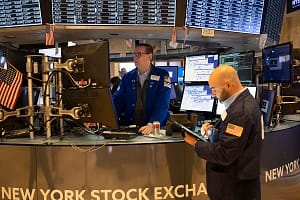UK equities are benefiting from investor diversification away from US tech amid economic uncertainty, with the FTSE trading at a modest 14.3x earnings versus the S&P 500’s 22.6x.
High dividend yields make UK stocks appealing in an income-focused environment. The index’s defensive, cash-generative composition, dominated by miners, defence, drinks, and tobacco, provides resilience, while cyclical and value exposure suits an inflationary, higher-rate backdrop.
Sterling weakness and domestic fiscal pressures can further enhance attractiveness relative to overseas peers.
Geopolitical uncertainty, commodity tailwinds, and structural trends like energy transition and AI bolster optimism.
Defence spending and positive pharmaceutical developments, including US deals, offer additional support. Combined, these factors suggest strong momentum for UK blue chips, making a FTSE 100 milestone of 10,000 by year-end a realistic possibility.
Best of times, worst of times. Earlier this year, the FTSE 100 acted as a safe harbour in a stormy market. Since then, UK blue chips have steadily climbed, with the index recently hitting a fresh intraday record, led by miners and financials. Several dynamics suggest the FTSE could reach 10,000 by year-end:
Diversification away from the US
Investors are moderating their heavy tech bets in the US. With ongoing economic policy uncertainty in Washington, UK equities provide relative shelter from implicit USD exposure, supporting the FTSE’s ascent.
Attractive valuations
The FTSE 100 trades at roughly 14.3x earnings, modestly below the 15x that would take it to 10,000. By contrast, the S&P 500 trades at 22.6x. After years of TINA (“there is no alternative”), macro conditions and higher terminal rates are making relative valuations relevant again.
Strong dividend yield
The FTSE offers the highest dividend yield among developed markets. With investors increasingly chasing income, UK equities may become ever more appealing.
Index composition
Defensive, cash-generative sectors, miners, defence, drinks, tobacco, dominate the FTSE. In an era where fundamentals like free cash flow and balance sheet strength matter, this composition is advantageous.
Cyclical and value exposure
Most FTSE earnings come from cyclical and value sectors, a plus in an inflationary, higher-rate environment. The UK is shifting from a decade of low growth and low rates to a “Roaring 20s”-style environment of higher nominal growth.
Sterling and UK weakness
Paradoxically, domestic fiscal chaos may help the FTSE. Pressure on gilts and sterling can make UK stocks more attractive relative to overseas peers. Sterling’s rally this year has already amplified the FTSE’s performance versus the US.
Geopolitical uncertainty
The Supreme Court’s new term could affect US trade policy. Market-watchers see potential volatility ahead—but any confirmation of US tariffs could reinforce the appeal of UK equities.
Commodity and macro tailwinds
Debt debasement, dollar weakness, and the 4D trade (debt, debasement, dollar, derivatives) favour FTSE miners. Energy transition, AI, and other megatrends add longer-term support, even amid near-term gold price fluctuations.
Defence spending
Investor appetite for defence stocks remains strong. Rising geopolitical tensions in Europe and continued Nato pressure underpin a structural tailwind for defence-related equities.
Pharma optimism
Pharmaceutical stocks, including AstraZeneca, have benefited from recent US deals. The easing of tariff-related uncertainty could provide an additional boost to the FTSE.
The FTSE 100 is supported by valuation, income, and sectoral composition, alongside macro and geopolitical tailwinds. If these factors continue, 10,000 by Christmas is more than a possibility, it’s a plausible target.






Leave a Comment